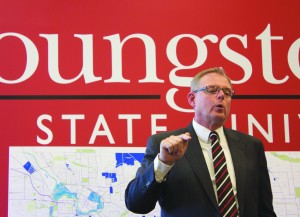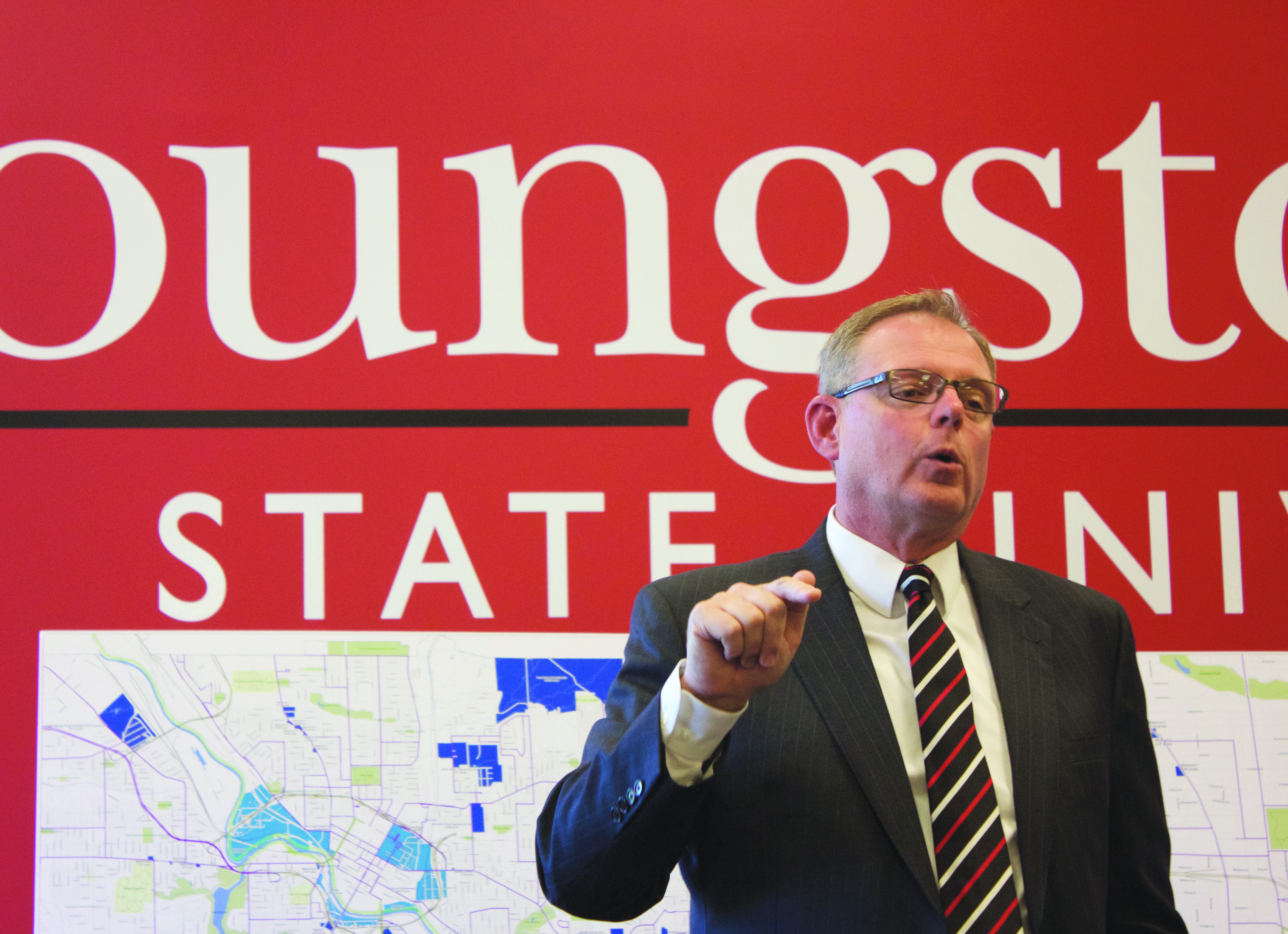By Justin Wier

Youngstown State University’s Center for Urban and Regional Studies unveiled a citywide economic development plan at the Covelli Centre on Tuesday.
The city and the university collaborated on the plan, which was the product of a $220,000 grant from the U.S. Economic Development Administration.
The 495-page document sets goals for development, identifies opportunity sites, includes case studies comparing Youngstown to similar cities and outlines a marketing campaign for the city.
The plan is focused on encouraging entrepreneurial activity, training citizens for jobs available in the city, creating a consortium of anchor institutions, promoting growth, continuing growth of the city core, increasing economic development in neighborhoods and investing in corridor and infrastructure upgrades.
Ronald Chordas, executive director of the Center for Urban and Regional Studies, presented the plan. He acknowledged the difficulty of implementing plans and said it will require long-term commitments from stakeholders, the community holding itself accountable and continued coordination and collaboration.
“The difference I see between this and other plans that have been around awhile is groups like CityScape, YSUScape — these young people are engaged in this process,” Chordas said. “They aren’t content to just let it die.”
He said it is easy to get federal grants for planning, but it’s more difficult to obtain funding to implement those plans.
“I’d like to see the federal government change their focus a little bit,” Chordas said. “We have enough plans. Let’s work on implementing these plans.”
Mayor John McNally said previous planning efforts like Youngstown 2010 — which focused on the growth of 58 different neighborhoods — were too broadly focused.
“That’s too much for a city to take on,” McNally said. “They certainly didn’t have the resources to do everything in the plan.”
Despite that, the mayor said Youngstown 2010 still inspired positive things, like the establishment of the Youngstown Neighborhood Development Corporation.
“From larger plans, we’ve got smaller pieces of work being done,” McNally said.
He said the current plan’s identification of opportunity zones and corridors are good for both the city and neighborhood groups who want to contribute to economic development.
They went corridor by corridor, identifying 1,200 acres across 2,000 parcels in the center city, along corridors and off corridors. Some of the corridors targeted for development are South Avenue, Market Street, Belmont Avenue, Oak Street and Poland Avenue.
Nick Chretien, an intern with the Center for Urban Research and Studies, helped with this part of the research.
“That was my life for a few months. It was pretty fun though, just finding different locations for potential businesses — both commercial and industrial — throughout the city,” Chretien said.
Thomas Maraffa, a geography professor who helped with the research, compared Youngstown with benchmark cities like Scranton, Pennsylvania, Green Bay, Wisconsin, Toledo, Ohio and Flint, Michigan.
“You want them to be comparable, but also aspirational,” Maraffa said.
He found that our central business district is near the bottom of the benchmark cities in terms of employment, establishments and payroll. However, our payroll per employee is near the middle of the distribution. In Youngstown, about two percent of the city’s employment, establishments and payroll are concentrated in the central business district. In other cities, it’s between 15 and 20 percent.
Maraffa said you could take the glass half-empty view that we are lagging behind other cities, or the optimistic view that we have room to grow, and it’s possible to do more with what we have.
Dominic C. Marchionda, city-university planner for the Center for Urban Research and Studies, said central business districts traditionally have the capacity to house about 10 percent of residents in a metropolitan statistical area. That means Youngstown could support nearly 6,000 more housing units if more jobs and businesses were located downtown for those residents.
Mike Hripko, associate vice president for research at YSU, said he will be taking on more responsibilities on behalf of the university for implementation of the plan.
“Those high level goals we’re going to maintain,” Hripko said. “Our strategies and our plans may change, but if we keep these in front of us as our top seven goals we’ll be directionally correct going forward.”
Hripko said establishing the consortium of anchor institutions is a big part of that, and the university has signed a memorandum of understanding with Mercy Health.
Chordas said the Center for Urban and Regional Studies will be coordinating efforts to obtain grants and financing.
“We have the connections to make it happen, so we’re going to be a big part of raising money and going forward with everything,” Chordas said.
McNally said the university and city realize they are joined at the hip in development efforts and their decision to work together is reason to be optimistic.
“The plan is continuing to foster and improve on the relationship between the city and the university,” McNally said. “I think you’re going to continue to see a lot more positive interaction between the two entities.”
